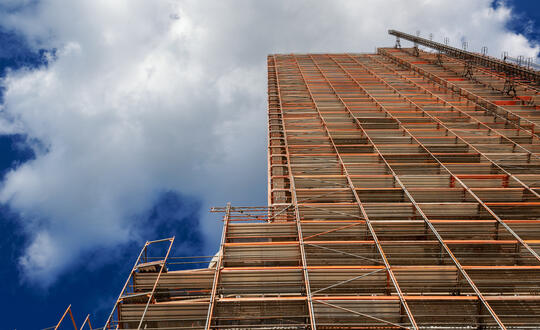
A view from the UK
In January last year, our prediction was that materials and labour shortages would continue to challenge the construction industry (although who could have predicted the massive scale of those shortages in 2021?)
We anticipate more of the same in 2022, but this time we have a year's worth of knowledge behind us, so while shortages will continue to impact the sector, the lessons we've learned will help us cope better with them - the key lesson, of course, being collaboration.
Shortages
Throughout 2021, we saw continual news stories about shortages in timber, cement, concrete, steel, cladding, roofing, white goods and more.
To end the year, the Construction Leadership Council's (CLC) Construction Product Availability statement (December 2021) stated that "the rapid increase in cases of Omicron is likely to impact production and operations into the New Year… Looking more closely at current and future challenges: Bricks and blocks remain in short supply… Demand for roof tiles remains high, with lead times averaging 24 weeks… tongue & groove remains in short supply".
There was some good news, as the CLC recognised that there were fewer issues with cement stocks and timber products than before, but this was caveated with an overarching comment that while we had seen improvements in supply levels at the end of the year, "this is largely due to a seasonal decline in activity".
Prices
The simple economics of shortages means that where there is short supply, there will be increased prices – which is exactly what we've been seeing.
In October 2021, Construction News reported that material costs surged by 23% in a year with "imported sawn or planed wood costing 74 per cent more than it did in August 2020, and fabricated stainless steel prices jumping by 74.8 per cent in the same period", and in November the RICS stated that construction materials cost increases had reached a 40-year high.
Labour shortages have led to increased costs too, with reports in September 2021 of skilled site labour costs leaping 3.6% in a single month.
Looking to 2022, there have already been warnings of a potential 10% rise in materials prices and increased construction and tender prices. This is exacerbated by the continuing shortage of HGV drivers and rise in energy prices.
Collaboration
The strain on construction companies has been immense, particularly for contractors where increased prices have taken huge bites out of their bottom line, and risks of disputes constantly loom due to shortages and inevitable delays. Where contracts have already been entered into, employers may argue that these are all risks that the contractor should manage. However, is that in the best interests of the project when shortages are an industry-wide dilemma? What happens where projects are still in the pre-contract stage?
Contractors alone cannot bear the risk and losses here. It is unsustainable for their individual businesses and, if those businesses start to collapse en masse, it is unsustainable for the industry, throwing the Government's plans for post-pandemic economic recovery into chaos.
In response to this, calls for collaboration are getting louder and louder. In May 2021, the CLC stressed that "wherever possible the industry must work collaboratively to manage this unprecedented situation to everyone’s benefit" and in December 2021, it again said "we encourage all sectors to continue to work closely and collaboratively to manage challenges and plan future work". Contractors are also asking employers to be more flexible when specifying building materials so they can avoid product shortages delaying the works.
In practice, we are starting to see more risk sharing, with the parties coming up with sensible solutions, like identifying certain "at risk" materials in a schedule and then sharing the risk on those materials, such as the employer taking programme risk and contractor taking price risk. Option X1 (Price adjustment for inflation) of the NEC is being discussed.
In the short term, with supply and prices changing sometimes monthly, discussions may be needed around how long and to what extent the contractor's tendered price and programme should be considered binding. Asking them to hold a price for months while a contract is negotiated is likely to become a thing of the past, because in that past, supply and prices were more stable, more predictable. Parties may be tempted to enter into the dreaded "letter of intent" to allow orders to be placed while supply is available and prices are per the original tender.
In the longer term, discussions need to continue around reducing construction wastage of materials, particularly in light of net zero targets. Greater adoption of modern methods of construction, where processes are designed to minimise waste and innovations can create efficiencies, can also help with this, but cannot be the sole answer.
A view from Germany - ways out of the building materials crisis
In the meantime, are there other lessons that we can learn from other countries? We asked Dr Udo Söns, partner at Redeker Sellner Dahs, WBD's alliance partner in Germany, to provide some insight:
Material shortages in the construction sector are a real issue in several countries.
The participants of the construction process in Germany must deal with difficulties in procuring materials as well as delays in delivery. In particular, steel, aluminium, electronics, synthetic products, cardboard packaging, wood, paper, cement or insulating materials are hardly available. Prices for some of these materials have increased between 5 to 85 per cent compared to the previous year. Furthermore, it has become more difficult to find specialists in the construction sector and manpower in general.
This development is especially disadvantageous for building contractors. They typically bear the manufacturing risk, the risk of unexpected price fluctuations and liability without fault. Therefore, relying on diligent and customary behaviour cannot exonerate them. They are unlikely to successfully invoke “force majeure” or other fundamental changes of circumstances to change this standard of liability. The German jurisdiction is rather reserved in such cases and didn’t even agree to an adjustment of prices during the oil crises in the 70’s.
Based on these remarks, which possible solutions exist to face these problems?
A contractor who wishes to avoid the aforementioned liability risks will have to consider whether they should store the building materials with supply bottlenecks at the time the contract is concluded, or agree on fixed prices with their subcontractors in order to avoid incalculable additional costs. Alternatively, they can negotiate prices that are based on certain price indices. Although the agreement of flexible prices is fundamentally prohibited under the German Price Clause Act, this does not apply to cost-based indices as an exception.
The client is, in terms of law, in a good position. They can demand fulfilment of the contract and, in the case of delays, compensation for default damages. They might even consider ordering changes and continue the construction with available or stable-priced materials. Even though change orders generally represent a price risk for the client, this will rarely be the case in the given situation, because the contractor does not incur any additional costs.
____________________
Co-authored by Redeker Sellner Dahs, with case study by Dr Udo Söns (Partner), facilitated by Philipp Hummel (Partner)
This article is for general information only and reflects the position at the date of publication. It does not constitute legal advice.





